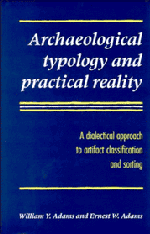 Archaeological Typology and Practical Reality
Archaeological Typology and Practical Reality Book contents
- Frontmatter
- Contents
- List of figures
- List of tables
- The archaeologist's preface
- The philosopher's preface
- PART I Introductory
- PART II The nature of types and typologies
- PART III Typology in action: the Medieval Nubian Pottery Typology
- PART IV Pragmatics of archaeological typology
- 13 The starting point: purpose
- 14 The determinants of types: variables and attributes
- 15 The making of types: formulation, designation and description
- 16 The use of types: typing and sorting
- 17 The ordering of types: taxonomy and seriation
- 18 Variation and variability in archaeological classifications
- 19 The bottom line: practicality
- 20 Principles of practical typology
- 21 Information-theoretic formulations
- PART V Classification, explanation, and theory
- Appendices
- References
- Index
16 - The use of types: typing and sorting
Published online by Cambridge University Press: 23 November 2009
- Frontmatter
- Contents
- List of figures
- List of tables
- The archaeologist's preface
- The philosopher's preface
- PART I Introductory
- PART II The nature of types and typologies
- PART III Typology in action: the Medieval Nubian Pottery Typology
- PART IV Pragmatics of archaeological typology
- 13 The starting point: purpose
- 14 The determinants of types: variables and attributes
- 15 The making of types: formulation, designation and description
- 16 The use of types: typing and sorting
- 17 The ordering of types: taxonomy and seriation
- 18 Variation and variability in archaeological classifications
- 19 The bottom line: practicality
- 20 Principles of practical typology
- 21 Information-theoretic formulations
- PART V Classification, explanation, and theory
- Appendices
- References
- Index
Summary
In Chapter 4 and Chapter 8 we defined a typology as a system of classification made specifically for the sorting of entities. We cannot state often enough that classifying (making categories) and sorting (putting things into them) are two different processes, each involving its own problems (cf. Jevons 1874, II: 394–6; Kluckhohn 1960: 135–6; Dunnell 1971b: 45; Vierra 1982: 162–3). The problems encountered in classifying are in the broadest sense problems of definition; they are partly theoretical (see Chapter 6), partly procedural, and partly judgmental (see Chapter 15). The problems in sorting are problems of recognition, and are purely judgmental. As we have observed several times before, even the inventors of types have to learn to use them in practice.
It is important at the outset to be clear about what it is we are recognizing in the sorting process. It is not, as is often suggested, a simple matter of identification (cf. Shepard 1965: 306–22; Clarke 1968: 187–91; Whallon 1972: 15; Voorrips 1982: 116–17), because in archaeology the type membership of an artifact is often far from obvious. What we are recognizing are the resemblances between specific entities and specific type concepts. That is, we are matching entities with concepts, and we have to decide for each individual entity which of several type concepts it most nearly resembles, and label it accordingly. Type application therefore involves the processes of matching and labeling, which we will designate collectively as type attribution.
- Type
- Chapter
- Information
- Archaeological Typology and Practical RealityA Dialectical Approach to Artifact Classification and Sorting, pp. 194 - 201Publisher: Cambridge University PressPrint publication year: 1991


